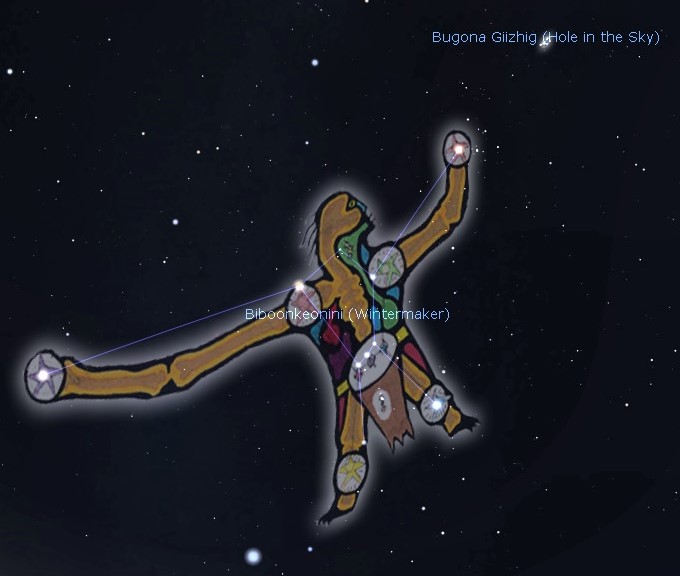This Week’s Sky at a Glance, 2021 January 16 – 23 ~by Curt Nason
Bright stars and eye-catching asterisms such as Orion’s Belt, the Big Dipper and the Pleaides were obvious targets to immortalize earthly creatures and activities. Rather than Orion being a hunter and the giant son of Poseidon, to the Egyptians he was Osiris, the god of light, riding up the Nile on a boat. In parts of China he was Commander Tsan, protecting farmers from barbarians seeking to steal their winter supplies. Brazilian tribes saw the figure as a turtle, or as the body of a giant caiman with its tail and head extending to constellations above and below Orion. The Inuit saw Orion’s belt and sword as three hunters pulling a sledge and chasing a bear, represented by the red star Betelgeuse, into the sky.
The Big Dipper forms the back half of the constellation Ursa Major, the Great Bear. In Britain it is The Plough, ancient Germans saw it as seven plowing oxen, and for others it was obviously a cart. Local First Nations people saw the bowl of the Big Dipper as a bear and the handle stars, along with other stars in the constellation Boötes, as hunters. The hunters, who are named for birds, chase the bear from spring to autumn until only the three closest hunters remain above the horizon, at which time the bear is slain by Robin. The bear’s blood stains Robin’s chest and the leaves of the trees.
The Pleiades represent seven daughters of Atlas and Pleione and they mark the shoulder of Taurus the Bull. The Maori of New Zealand imagined them as the prow of their founder’s canoe, with the upper half of Orion forming the stern. Cherokee legend in the southeastern United States tells of seven boys who, in response to being punished for not working, performed a Feather Dance and ascended to the sky. To the Ojibwe, Orion was the Wintermaker and the Pleiades the Hole-in-the-Sky.
This Week in the Solar System
Saturday’s sunrise in Moncton is at 7:56 am and sunset will occur at 5:01 pm, giving 9 hours, 5 minutes of daylight (7:58 am and 5:09 pm in Saint John). Next Saturday the Sun will rise at 7:51 am and set at 5:11 pm, giving 9 hours, 20 minutes of daylight (7:53 am and 5:19 pm in Saint John).
The Moon is at first quarter on Wednesday, passing below Uranus and Mars in the early evening. Midweek Uranus will be the brightest “star” half a binocular field below Mars. Jupiter might still be visible in binoculars this weekend, setting 40 minutes after sunset. Mercury should be visible in binoculars and setting at 6:30 pm this weekend, and next weekend it reaches greatest elongation from the Sun. Mars is high in the south in evening twilight, glowing as brightly as Vega. Venus rises an hour before sunrise this weekend and in a few weeks it will be welcoming Saturn and Jupiter to the morning sky.
With astronomy meetings and outreach activities on hold, you can watch the local Sunday Night Astronomy Show at 8 pm and view archived shows.
Questions? Contact Curt Nason.

